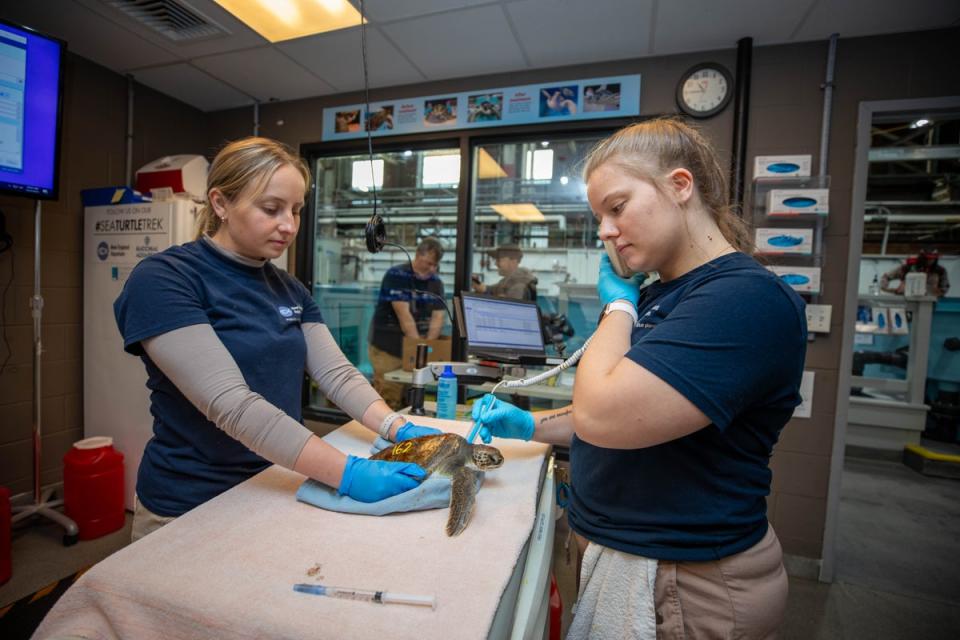Hundreds of young sea turtles in critical condition from hypothermia washed up on the coast of Cape Cod in Massachusetts this month.
While conservationists expect so-called 'cold stunning' events as temperatures drop, this year has been particularly bad due to strong winds forcing more turtles onto land to escape the cold water, with deadly consequences.
Sea turtles are cold-blooded and cannot regulate their body temperature. Cold stunning occurs when the water temperature drops below 50 degrees. It can be life-threatening if the reptiles are exposed to the water for several days. The turtles become weak and cannot regulate their buoyancy, often floating to the surface of the water and not moving to conserve energy.
“We typically see a lot of pneumonia in these turtles. They are very underweight, very dehydrated. Some animals suffer fractures from interacting with blood vessels or when they wash up on rocks,” said Adam Kennedy, director of rescue and rehabilitation at the New England Aquarium. The independent on Tuesday. “But they're in pretty bad shape because they actually wandered around for a few months before they got stranded. So it's amazing that they're actually still alive when they reach the beach.”

A Kemp's ridley sea turtle is examined at the New England Aquarium's Sea Turtle Hospital. Many of the critically endangered animals have washed up on the shores of Massachusetts this month (Vanessa Kahn/New England Aquarium)
Cold stunning occurs when many of the turtles are affected at the same time in the same area, and Cape Cod Bay is a common beach location. They look like rocks along the coast.
If not found, they die from medical conditions related to hypothermia and the inability to feed. Although mortality rates have fallen since the first major cold snap in 2001 due to improved human response.
The aquarium currently cares for more than 200 turtles at the Sea Turtle Hospital in Quincy, many of which are the critically endangered Kemp's ridley species – the most endangered and smallest of all sea turtle species. Rescuers have also spotted endangered green sea turtles and loggerheads. Kennedy said he expected 25 new turtles to arrive Tuesday morning, with more arriving in the afternoon.

New England Aquarium biologists check the heart rate of a rescued sea turtle. The sea turtles are also given fluids and antibiotics as they arrive after a cold stun (Vanessa Kahn/New England Aquarium)
“Yesterday we received 76 live turtles into our facility. That is one of the biggest intake days we have had here,” he said.
When the aquarium finds the turtles, they take x-rays and perform blood tests. Medical personnel also determine their heart rate. Turtles with a heart rate of less than 10 beats per minute are given an injection of epinephrine, also known as adrenaline, to boost their hearts. Turtles that are struggling are given special fluids, and all turtles are given a basic fluid plan and antibiotics.
The turtles in need of assistance will be slowly introduced to warmer and saltier waters over a period of three days. The better responding turtles are taken to the swimming area of the aquarium. The patients are monitored to make sure they are doing well. Once they are strong enough, they can be transported to other places that can care for them. After weeks or months of care, they can be released back into the ocean.
“When we first moved to our off-site location in Quincy in 2010, there was an average of 38 to 40 turtles. And now our annual average is just over 400 turtles, and most of those are the critically endangered Kemp's sea turtle,” Kennedy explains.
There are several reasons for these strandings along the Atlantic Ocean coast. Sea turtles travel thousands of miles each year and prefer tropical ocean temperatures between 70 and 80 degrees. The young float on the Gulf Stream, a strong ocean current that brings warm water from the Gulf of Mexico to the Atlantic Ocean.
However, after spending an enjoyable summer in Cape Cod Bay, they can become trapped during the cold months, especially in high winds. “We didn't have that wind last year,” Kennedy said.
As ocean temperatures continue to rise due to climate change, sea turtles are following these waters further north in the summer, the National Aquarium notes, taking them outside of traditional migration routes.

Staff, volunteers and interns at the New England Aquarium's Sea Turtle Hospital evaluate dozens of rescued sea turtles during the admission process. Without rescue and treatment, the turtles would die (Vanessa Kahn/New England Aquarium)
“The warming of the Gulf of Maine over the years may allow more and more turtles to enter Cape Cod Bay,” Kennedy added. “Most likely this is due to the warming we are seeing.”
Unfortunately, these factors have led to more of these occurrences. Data from Mass Audubon shows that the number of affected turtles in the Northeast has increased dramatically over the past decade.
“There are models that say that by 2030 we will see more than a thousand turtles every year. We'll get there. I see that happening and we're getting ready to be ready for that,” Kennedy said.
Although the New England Aquarium receives help from the nonprofit Turtles Fly Too and other facilities, it was built for only about 60 turtles. On Tuesday, it launched a campaign to support their efforts, with donations of $100,000 per dollar.
“We are fortunate to have such a great network of sea turtle rehabilitation centers,” Kennedy said. “Very fortunate that people really care about sea turtles.”

